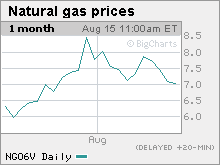|
Gulf leaves gas supplies in precarious position As the Atlantic hurricane season gets into full swing, natural gas production and infrastructure are still recovering from last year's storms. NEW YORK (CNNMoney.com) -- Two years after Hurricane Ivan, and nearly a year after both Rita and Katrina tore through the Gulf of Mexico, energy production in the region still has some big problems. Pipelines on the sea floor which deliver most of the region's oil and gas to shore remain twisted. Key ports on the Louisiana coast are just now limping back to life. And a big chunk of the region's energy production remains shut down.
According to the federal Minerals Management Service, the equivalent of 165,000 barrels per day of natural gas production is still offline. That means the Gulf is producing the equivalent of 1.7 million bpd of natural gas, which is about 9 percent below full capacity. That's not as steep of a reduction as oil has seen in the region, where roughly 180,000 bpd of oil, or nearly 12 percent of the Gulf's current 1.5 million bpd output is still shut in. But this cut in natural gas production could have a greater effect on natural gas prices than the corresponding cut in the Gulf's oil production. That's because oil can be moved by tanker around the globe to cover localized shortages, easing price spikes, while natural gas cannot be easily transported this way. This fragile state of affairs in the Gulf, along with the record-breaking heat that's blanketed large parts of the country, is what pushed natural gas prices up over 40 percent last month. Prices have cooled since then, but they're still up roughly 15 percent from mid-July. Some energy traders say there is plenty of natural gas around and forecast that, barring an "unforeseen event" like a major hurricane, prices should remain flat to lower. But with Gulf infrastructure in the condition it is, and with experts predicting an active hurricane season, there is reason to fear another price spike. "Everybody is scared of even a midsized storm coming through," said John Sullivan, a Houston-based analyst at the Energy Intelligence Group who covers Gulf of Mexico issues. "If a monster storm like Rita shows up, all bets are off." Getting back in the game Sullivan said there are several reasons why energy production in the region is having such a hard time coming back online. People tend to think of only Rita and Katrina when talking about the destruction to the industry. But Sullivan said Ivan tore up a lot of infrastructure when it came through two years ago, and production never fully recovered from that. "You're talking about a cumulative effect here," he said. "People are still fixing things broken in 2004." Last year's storms not only knocked out platforms and pipelines, but also hit key logistics bases on the Louisiana coast. These bases are essential to Gulf operations. Oil and oil service companies use them as heliports, storage centers for supplies like water and fuel for rigs, and as staging areas to assemble giant prefabricated parts for the rigs themselves. Sullivan said there are five ports in Louisiana that were damaged which are especially important. The biggest one is in Venice and is only now starting to reopen for operations. Until all of these ports are fully operational again, he said oil companies will have to rely on ports that are further away and aren't designed for this specific task, making things more difficult and more expensive. Meanwhile, the surge in demand for skilled workers who can dive to inspect pipelines and can weld underwater to fix them has caused a labor shortage across the entire industry. "[Rebuilding is] just not a process that is very easy to do or very quick to do," said Sullivan. Hurricanes and your heating bill So what does all this mean for the price of natural gas? Traders said the spike earlier this month was not unusual, as industries that use large amounts of natural gas and nervously buy up supplies ahead of hurricane season and during times of peak summer electricity demand. "During hurricane season people are afraid of getting caught in a squeeze," said Sal Gilbertie, and energy trader at Fimat in New York. And Brian Hicks, co-manager of the Global Resources Fund at U.S. Global Investors in San Antonio, said this year's run up was also a little more exaggerated, because a warm winter created a build up in supplies that depressed prices at the beginning of the summer. Both Hicks and Gilbertie see natural gas prices staying relatively stable. Unless, of course, a big storm moves through. But Gilbertie said one can't trade around storm speculation. "Do I think we're gonna get a major hurricane? How should I know?" he said. "You'd be better off asking weather man." Beyond Prudhoe: Why BP should go back to being an oil company |
|


